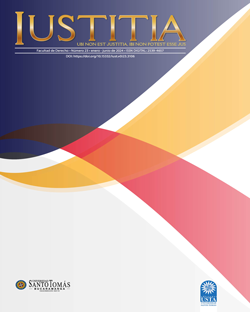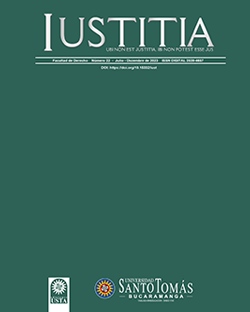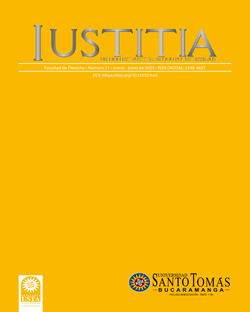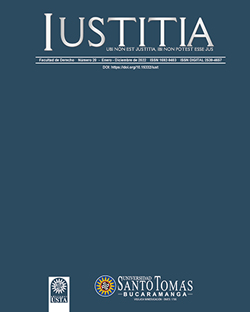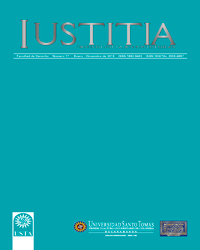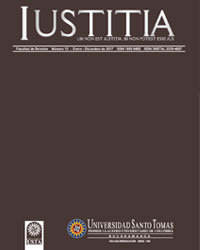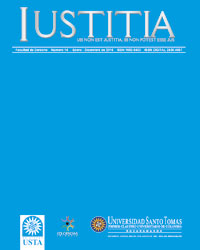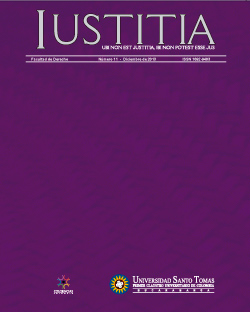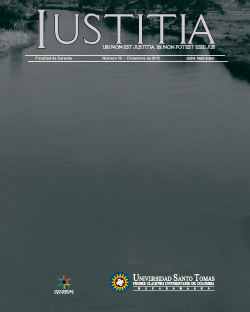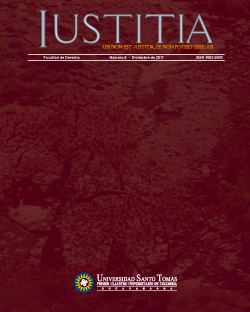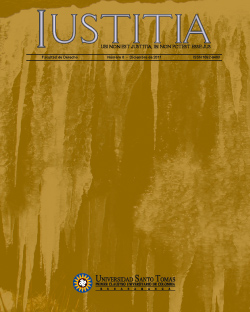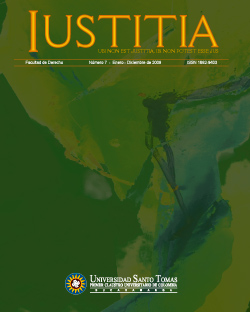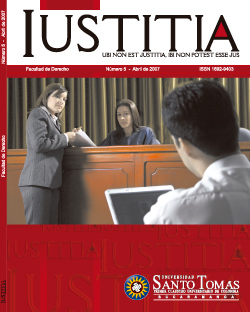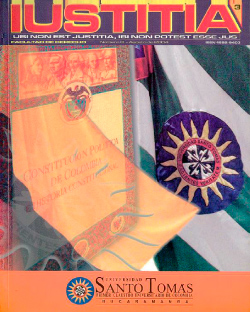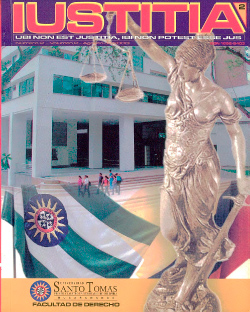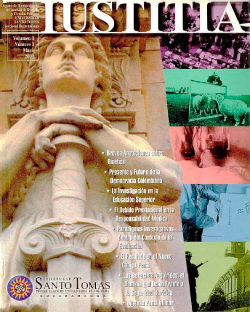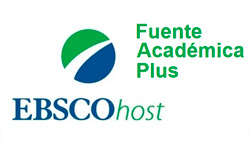General Instructions for Authors:
The IUSTITIA Journal, affiliated with the Division of Legal and Political Sciences and the Faculty of Law at Universidad Santo Tomás Seccional Bucaramanga, is committed to complying with the indexing requirements set forth by the Ministry of Sciences. As such, the following publication rules must be adhered to when submitting contributions:
Unpublished and Original Articles: The Editorial Committee requires that submitted articles be both unpublished and original, without any prior partial or total publication.
Author's Curriculum Vitae: Each article should be accompanied by the author's comprehensive Curriculum Vitae, which must include the author's full name, date of birth, nationality, educational background, affiliations with research centers or institutions, and current position held. Additionally, the Curriculum Vitae should provide details of previously published articles, book chapters, and books, including the title, name of the journal or compilation, ISSN or ISBN, total number of pages in the full text, number of pages in the article or chapter, year of publication, publisher, and country.
Arbitration Process - Peer Review:
To initiate the evaluation process, submitted articles will undergo a preliminary review to ensure compliance with the requirements stated in the call for submissions. Subsequently, the Editor will present the articles to the Editorial and Scientific Committees for an initial selection of materials deemed relevant to the thematic areas covered by the Journal. This review will also assess the authors' adherence to formal requirements, ultimately determining whether the article should proceed to peer review.
Articles failing to meet the formal requirements will be returned to the authors within one month from the submission deadline. Authors will then can make the necessary adjustments and decide whether to submit their work to other journals.
The selected articles will undergo the following process:
Peer Review: Expert evaluators in the respective fields will conduct a double-blind review of the articles. This means that the authors will be unaware of the identity of the evaluators, and vice versa.
Timelines: Peer review shall be completed within a maximum of three (3) months. Upon completion, the Editor will notify the authors of the results and provide supporting arguments.
Evaluation Criteria: The peer review process will assess the academic quality, rigor, and adherence to appropriate academic publication norms of the submitted text to determine its suitability for publication.
Review Results: The author will receive the peer reviewers' evaluation, including the following outcomes:
Article accepted for publication without modifications.
Article accepted for publication with minor modifications.
Article accepted for publication with major modifications, requiring authors to adjust within a maximum of fifteen (15) calendar days. A new evaluation will be necessary following the revisions.
Article not accepted for publication.
Communication of Evaluation: The peer reviewers' evaluation will be communicated to the authors in all cases.
Corrections and Modifications: Should the articles require adjustments in form or content, authors will be given fifteen (15) calendar days to make the necessary corrections.
Non-Response: If no response is received with the adjusted article from the author, it will be assumed that they have abandoned their interest in publishing it in the journal.
Final Opinion: Once the authors have made the required adjustments and modifications, the Editorial Committee will provide its final opinion.
Style Correction and Layout: Articles accepted for publication will undergo the necessary processes of style correction and layout, performed by the Publications Department of Santo Tomás University Bucaramanga.
Open Access Policy:
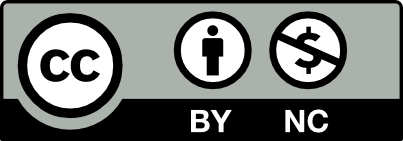
This work is licensed under licencia de Creative Commons Reconocimiento-NoComercial 4.0 Internacional
This journal provides immediate open access to its content on the principle that making research freely available to the public supports a greater global exchange of knowledge.
The IUSTITIA Journal upholds the principle of promoting global knowledge exchange by providing free and immediate access to its content. This approach fosters academic dialogue and debate without imposing any charges on readers or authors.
Frequency of Publication:
The IUSTITIA Journal is an annual publication released every December.
Instructions for Authors:
Form of Article Presentation:
The IUSTITIA Journal accepts articles in the following typologies:
Research Articles: These scientific documents present partial or definitive research results, showcasing novel and significant findings in a specialized field of knowledge. They follow the IMRyD structure, consisting of Introduction, Methodology, Results, and Discussion.
Reflection Articles: Original documents that offer research results from the author's analytical, interpretive, and critical perspective on a specific topic. These articles utilize original sources and operate as critical essays, analyzing one's own or others' research findings and providing a viewpoint on their impact on social reality or the academic field. They can also be constructed as meta-analyses of prevailing debates in the specialized field, where the author presents their own thesis based on dominant, alternative, and critical ideas in the field.
Review Articles: These articles organize, analyze, and integrate published or unpublished research on a particular scientific or technological field, highlighting advancements and development trends. They extensively analyze literature, theories, and existing works related to a specialized field of knowledge. Review articles require substantial documentation and theoretical referencing to establish a robust knowledge foundation, current reflections, and analytical abilities. They should include a minimum of 40 bibliographic references.
Structuring Articles:
Research Articles should adhere to the following structure:
I. Title: A concise and comprehensible title of no more than 13 words, avoiding excessive use of prepositions and articles. Abbreviations are not permitted.
II. Author(s): Full name(s) of the author(s), along with their academic profiles and institutional affiliations with IUSTITIA or other institutions. Only the author(s) of the text should be listed, excluding advisors or directors. Co-authored documents involving a maximum of four (4) individuals are accepted for this call.
III. Abstract: A summary of the article's structure and main content, ranging from 150 to 250 words. It should include:
a. The objective or possible hypothesis to be demonstrated.
b. Sections of the document (titles, subtitles).
c. An overview of the results or conclusions, depending on the article's nature (review, reflection, or research).
IV. Keywords: Self-explanatory and guiding terms or phrases that describe the themes presented in the article. Five (5) keywords are required, which should be translated into English.
V. Introduction: This section encompasses the research purpose or objective, a concise overview of the state of the art, historical background, and the practical significance of the results.
VI. Methodology: The chosen methodological approach and research techniques employed throughout the investigation should be described in this section.
VII. Results: Clear and concise presentation of outcomes aligned with the objectives outlined in the research proposal, offering an account of the positive or negative findings resulting from the academic research exercise.
VIII. Conclusion: Interpretation of the results within the framework of theoretical, conceptual, legal, and/or jurisprudential references. This section serves as an opportunity for the author to present general conclusions from the research process and suggest future avenues of inquiry.
IX. References: A list of sources cited within the submitted document.
Reflection and reviewing Articles.
Regarding the two article typologies mentioned, in comparison to the original scientific article, the following structure will be considered:
I. Title: The title should be concise, not exceeding 13 words, and avoid excessive use of prepositions and articles. It should be clear, precise, and easily understandable. Abbreviations must be avoided.
II. Author: The author's full name, academic profile, and institutional affiliation should be provided, regardless of their relationship with the IUSTITIA Journal. Only the author(s) who contributed to the text should be listed, excluding any accompanying advisors or directors. For this call, articles with a maximum of four (4) co-authors will be accepted.
III. Abstract: This section aims to provide readers with an orientation regarding the article's main structure and content. The summary paragraph should consist of a minimum of 150 words and a maximum of 250 words. It should include:
a. The article's objective.
b. Sections of the document (titles, subtitles).
c. An overview of the results or conclusions, depending on the article's typology (review, reflection, or research).
IV. Keywords: Descriptive and self-explanatory terms that indicate the thematic areas covered in the text. They should be clear and precise. Five (5) keywords are required, and they should be translated into English as well.
V. Introduction: This section should encompass the research purpose or objective, along with a summary of the state of the art, historical background, and the significance of the results (briefly and propositionally).
VI. Content: In the case of a reflection article, this section should present the theoretical or practical analysis proposed as a thesis derived from the author's academic exercise. For a review article, this section should contain the results of the analytical exploration of existing theories and works related to a specialized field of knowledge.
VII. Results or Critical Analysis: In a reflection article, this section should include a discussion with antitheses or alternative theories that the proposed thesis must confront. For a review article, this section should present the results of the theoretical assessment conducted to establish the categorization of the impact or importance of each perspective in the specialized field of knowledge and reach a theoretical decision as the author.
VIII. Conclusions: This section should interpret the results within the context of the theoretical, conceptual, legal, and/or jurisprudential framework. This is the moment for the author to provide general conclusions of the reflection or review process and suggest future avenues for inquiry.
IX. References: This section should list all the sources cited within the submitted document.
Final Instructions:
The document should be submitted in digital format using Microsoft Word, with a minimum length of 15 pages and a maximum of 25 pages (excluding the final list of references).
Please use Times New Roman font size 12, with 1.5 line spacing, and standard margins in a Microsoft Word document (2.5 cm on each side of the margin).
The document should include an abstract and 5 keywords in both Spanish and English. Additionally, all citations must follow the APA 7th edition format, both in in-text citations and the reference list. Symbols and abbreviations, such as CSJC (Colombian Supreme Court of Justice), should be defined in a footnote the first time they are mentioned.
Tables and figures must be numbered consecutively, starting with number 1 (e.g., Figure 1). The title should be in lowercase and italicized, positioned at the top of the table or figure, and in Arial 10 font.
Finally, figures and tables should be referenced in Arial 8 font. The document must be submitted by March 30th, Vol. 1 and, September 30th Vol 2, to the email address Esta dirección de correo electrónico está protegida contra spambots. Necesita activar JavaScript para visualizarla.
Guide to develop references
References should be included within the text; according to the editorial style manual American Psychological Association [APA], 2017, Seventh Edition, will operate for both citations and references.
Below, we transcribe some examples contained in American Psychological Association [APA], 2017) Seventh edition pages 480 to 497
Journal article with DOI
McCauley, S. M., & Christiansen, M. H. (2019). Language learning as language use: A cross-linguistic model of child language development. Psychological Review, 126(1), 1–51. https://doi.org/10.1037/rev0000126
Parenthetical citation: (McCauley & Christiansen, 2019)
Narrative citation: McCauley and Christiansen (2019)
Journal article without a DOI with nondatabase URL
Ahmann, E., Tuttle, L. J., Saviet, M., & Wright, S. D. (2018). A descriptive review of ADHD coaching research: Implications for college students. Journal of Postsecondary Education and Disability, 31(1), 17–39. https://www.ahead.org/professionalresources/ publications/jped/archived-jped/jped-volume-31
Parenthetical citation: (Ahmann et al., 2018)
Narrative citation: Ahmann et al. (2018)
Journal, magazine or newspaper article without DOI, from most academic research databases or print version
Anderson, M. (2018). Getting consistent with consequences. Educational Leadership, 76(1), 26–33.
Goldman, C. (2018, November 28). The complicated calibration of love, especially in adoption. Chicago Tribune.
Parenthetical citations: (Anderson, 2018; Goldman, 2018)
Narrative citations: Anderson (2018) and Goldman (2018)
Journal article with DOI 21 or more authors
Kalnay, E., Kanamitsu, M., Kistler, R., Collins, W., Deaven, D., Gandin, L., Iredell, M., Saha, S., White, G., Woollen, J., Zhu, Y., Chelliah, M., Ebisuzaki, W., Higgins, W., Janowiak, J., Mo, K. C., Ropelewski, C., Wang, J., Leetmaa, A., . . . Joseph, D. (1996). The NCEP/NCAR 40-year reanalysis project. Bulletin of the American Meteorological Society, 77(3), 437–471. http://doi.org/fg6rf9
Parenthetical citation: (Kalnay et al., 1996)
Narrative citation: Kalnay et al. (1996)
Journal article with DOI, combination of individual and group authors
De Vries, R., Nieuwenhuijze, M., Buitendijk, S. E., & the members of Midwifery Science Work Group. (2013). What does it take to have a strong and independent profession of midwifery? Lessons from the Netherlands. Midwifery, 29(10), 1122–1128. https://doi.org/10.1016/j.midw.2013.07.007
Parenthetical citation: (De Vries et al., 2013)
Narrative citation: De Vries et al. (2013)
Blog post
Klymkowsky, M. (2018, September 15). Can we talk scientifically about free will? Sci-Ed. https://blogs.plos.org/scied/2018/09/15/can-we-talkscientifically- about-free-will/
Parenthetical citation: (Klymkowsky, 2018)
Narrative citation: Klymkowsky (2018)
Journal article, advance oline publication.
Huestegge, S. M., Raettig, T., & Huestegge, L. (2019). Are faceincongruent voices harder to process? Effects of face–voice gender incongruency on basic cognitive information processing. Experimental Psychology. Advance online publication. https://doi.org/10.1027/1618-3169/a000440
Parenthetical citation: (Huestegge et al., 2019)
Narrative citation: Huestegge et al. (2019)
Journal article, in press
Pachur, T., & Scheibehenne, B. (in press). Unpacking buyer– seller differences in valuation from experience: A cognitive modeling approach. Psychonomic Bulletin & Review.
Parenthetical citation: (Pachur & Scheibehenne, in press)
Narrative citation: Pachur and Scheibehenne (in press)
Journal article, published in another language
Chaves-Morillo, V., Gómez Calero, C., Fernández-Muñoz, J. J., Toledano-Muñoz, A., Fernández-Huete, J., Martínez-Monge, N., Palacios-Ceña, D., & Peñacoba-Puente, C. (2018). La anosmia neurosensorial: Relación entre subtipo, tiempo de reconocimiento y edad [Sensorineural anosmia: Relationship between subtype, recognition time, and age]. Clínica y Salud, 28(3), 155–161. https://doi.org/10.1016/j.clysa.2017.04.002
Parenthetical citation: (Chaves-Morillo et al., 2018)
Narrative citation: Chaves-Morillo et al. (2018)
Journal article, republished in traslation
Piaget, J. (1972). Intellectual evolution from adolescence to adulthood (J. Bliss & H. Furth, Trans.). Human Development, 15(1), 1–12. https://doi.org/10.1159/000271225 (Original work published 1970)
Parenthetical citation: (Piaget, 1970/1972)
Narrative citation: Piaget (1970/1972)
Journal article, reprinted form another source
Shore, M. F. (2014). Marking time in the land of plenty: Reflections on mental health in the United States. American Journal of Orthopsychiatry, 84(6), 611–618. https://doi.org/10.1037/h0100165 (Reprinted from “Marking time in the land of plenty: Reflections on mental health in the United States,” 1981, American Journal of Orthopsychiatry, 51[3], 391–402, https://doi.org/10.1111/j.1939-0025.1981.tb01388.x)
Parenthetical citation: (Shore, 1981/2014)
Narrative citation: Shore (1981/2014)
Special Section or special issue in a journa
Lilienfeld, S. O. (Ed.). (2018). Heterodox issues in psychology [Special section]. Archives of Scientific Psychology, 6(1), 51– 104.
McDaniel, S. H., Salas, E., & Kazak, A. E. (Eds.). (2018). The science of teamwork [Special issue]. American Psychologist, 73(4).
Parenthetical citations: (Lilienfeld, 2018; McDaniel et al., 2018)
Narrative citations: Lilienfeld (2018) and McDaniel et al. (2018)
Newspaper article
Guarino, B. (2017, December 4). How will humanity react to alien life? Psychologists have some predictions. The Washington Post. https://www.washingtonpost.com/news/speaking-of- science/wp/2017/12/04/how-will-humanity-react-to-alien-lifepsychologists-have-some-predictions
Hess, A. (2019, January 3). Cats who take direction. The New York Times, C1.
Parenthetical citations: (Guarino, 2017; Hess, 2019)
Narrative citations: Guarino (2017) and Hess (2019)
Editorial
Cuellar, N. G. (2016). Study abroad programs [Editorial]. Journal of Transcultural Nursing, 27(3), 209. https://doi.org/10.1177/1043659616638722
Parenthetical citation: (Cuellar, 2016)
Narrative citation: Cuellar (2016)
Authored Book with a DOI
Brown, L. S. (2018). Feminist therapy (2nd ed.). American Psychological Association. https://doi.org/10.1037/0000092- 000
Parenthetical citation: (Brown, 2018)
Narrative citation: Brown (2018)
Authored Ebook or audiobook without a DOI with nondatabase URL
Cain, S. (2012). Quiet: The power of introverts in a world that can’t stop talking (K. Mazur, Narr.) [Audiobook]. Random House Audio. http://bit.ly/2G0BpbI
Christian, B., & Griffiths, T. (2016). Algorithms to live by: The computer science of human decisions. Henry Holt and Co. http://a.co/7qGBZAk
Parenthetical citations: (Cain, 2012; Christian & Griffiths, 2016)
Narrative citations: Cain (2012) and Christian and Griffiths (2016)
Authored book with editor credited on the book cover
Meadows, D. H. (2008). Thinking in systems: A primer (D. Wright, Ed.). Chelsea Green Publishing.
Parenthetical citation: (Meadows, 2008)
Narrative citation: Meadows (2008)
Edited book with a DOI, whit multiple publishers
Schmid, H.-J. (Ed.). (2017). Entrenchment and the psychology of language learning: How we reorganize and adapt linguistic knowledge. American Psychological Association; De Gruyter Mouton. https://doi.org/10.1037/15969-000
Parenthetical citation: (Schmid, 2017)
Narrative citation: Schmid (2017)
Book in another language
Amano, N., & Kondo, H. (2000). Nihongo no goi tokusei [Lexical characteristics of Japanese language] (Vol. 7). Sansei-do.
Piaget, J., & Inhelder, B. (1966). La psychologie de l’enfant [The psychology of the child]. Quadrige.
Parenthetical citations: (Amano & Kondo, 2000; Piaget & Inhelder, 1966)
Narrative citations: Amano and Kondo (2000) and Piaget and Inhelder (1966)
Book republished in traslation
Piaget, J., & Inhelder, B. (1969). The psychology of the child (H. Weaver, Trans.; 2nd ed.). Basic Books. (Original work published 1966)
Parenthetical citation: (Piaget & Inhelder, 1966/1969)
Narrative citation: Piaget and Inhelder (1966/1969)
Republished book, Ebook or audiobook
Freud, S. (2010). The interpretation of dreams: The complete and definitive text (J. Strachey, Ed. & Trans.). Basic Books. (Original work published 1900)
Rowling, J. K. (2015). Harry Potter and the sorcerer’s stone (J. Dale, Narr.) [Audiobook]. Pottermore Publishing. http://bit.ly/2TcHchx (Original work published 1997)
Parenthetical citations: (Freud, 1900/2010; Rowling, 1997/2015)
Narrative citations: Freud (1900/2010) and Rowling (1997/2015)
Dictionary, thesaurus or encyclopedia
American Psychological Association. (n.d.). APA dictionary of psychology. Retrieved June 14, 2019, from https://dictionary.apa.org/
Merriam-Webster. (n.d.). Merriam-Webster.com dictionary. Retrieved May 5, 2019, from https://www.merriamwebster.com/
Zalta, E. N. (Ed.). (2019). The Stanford encyclopedia of philosophy (Summer 2019 ed.). Stanford University. https://plato.stanford.edu/archives/sum2019/
Parenthetical citations: (American Psychological Association, n.d.; Merriam-Webster, n.d.; Zalta, 2019)
Narrative citations: American Psychological Association (n.d.), Merriam-Webster (n.d.), and Zalta (2019)
Religious work
King James Bible. (2017). King James Bible Online. https://www.kingjamesbibleonline.org/ (Original work published 1769)
The Qur’an (M. A. S. Abdel Haleem, Trans.). (2004). Oxford University Press.
The Torah: The five books of Moses (3rd ed.). (2015). The Jewish Publication Society. (Original work published 1962)
Parenthetical citations: (King James Bible, 1769/2017; The Qur’an, 2004; The Torah, 1962/2015)
Narrative citations: King James Bible (1769/2017), The Qur’an (2004), and The Torah (1962/2015)
Ancient Greek or Roman work
Aristotle. (1994). Poetics (S. H. Butcher, Trans.). The Internet Classics Archive. http://classics.mit.edu/Aristotle/poetics.html (Original work published ca. 350 B.C.E.)
Parenthetical citation: (Aristotle, ca. 350 B.C.E./1994)
Narrative citation: Aristotle (ca. 350 B.C.E./1994)
Shakespeare
Shakespeare, W. (1995). Much ado about nothing (B. A. Mowat & P. Werstine, Eds.). Washington Square Press. (Original work published 1623)
Parenthetical citation: (Shakespeare, 1623/1995)
Narrative citation: Shakespeare (1623/1995)
For additional examples, review the American Psychological Association [APA], 2017 Seventh Edition.
Declaration of Ethics and Good Practices
Editorial Responsibilities
The editor of the IUSTITIA journal must act impartially in evaluating submitted texts, while ensuring freedom of expression, and respecting the rights of third parties. The editor must prevent any defamatory or false statements and promote good editorial practices, ensuring full compliance with ethical and scientific standards by the authors. The editor must also protect the integrity of the documents.
Double-blind evaluation will be conducted with absolute privacy maintained by the editor, the Editorial Committee, and the Scientific Committee. Furthermore, articles will undergo a similarity check using the Turnitin program.
If any evidence of malpractice, such as plagiarism, data falsification, or improper citation of sources, is detected, the Editorial Committee will notify the author of the situation to provide the opportunity for rebuttal and defense. After receiving the author's response, the Editorial Committee will decide whether to publish the article in the IUSTITIA journal.
Authors Responsibilities
Authors submitting articles must provide a written declaration stating that:
• The article is an original work and has not been simultaneously submitted to another publication.
• They hold exclusive ownership of the author's moral and patrimonial rights.
• In case of multiple authors, all authors have contributed intellectually to its elaboration.
• Each author has read and approved the final version of the submitted manuscript.
• When part of the content of the article has been published or disclosed by another means, the authors must acknowledge and cite the respective sources and academic credits.
• The current ethical standards were followed in the research.
• The copyright has been respected, and proper citations have been made for any transcriptions or paraphrasing incorporated into the article.
• The results and conclusions presented in the article are truthful.
• They subscribe and authorize in the license of use, the disclosure of the work in the IUSTITIA journal in both printed and digital media for academic purposes and through non-profit dissemination.
Anti-plagiarism Policy
After the pre-selection of received articles for each edition, the article's text will undergo a similarity check on the Turnitin platform. As this practice is part of the journal's editorial policy, authors agree to have their article's text reviewed on the Turnitin tool.
Responsibilities of Referees - Peer Reviewers
If elements of plagiarism or similarity are detected, or if it becomes known that the text has been previously published in another publication, referees - peer reviewers have an obligation to inform the editor.
Referees - peer reviewers must refrain from evaluating articles in which they have any conflicts of academic interest.
Publicity
The IUSTITIA journal strictly prohibits the inclusion of any advertising in its print or digital editions.
Ownership and Management
The journal is solely financed by resources from Santo Tomás University, and therefore, authors are not charged for the submission and publication of articles in the IUSTITIA journal.
Reception and Publication Costs of Articles
The IUSTITIA journal does not impose any fees on authors for the reception and publication of articles.
Publication Schedule
The journal follows an annual publication schedule, with releases occurring in December of each year. Calls for papers and the editorial schedule are published on the journal's website.



